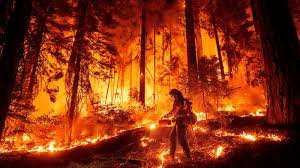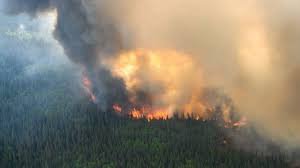
Human, ecological and climate factors are working together that are making wildfires stronger and faster than experienced before. Let us discuss some of the major issues:
1. Global Warming
Increased Temperature: The growing temperatures around the world are promoting dryness and making seasons longer. As a result, temperatures easily combust plant life.
Increased Drought Conditions: Soil and plant moisture is lower due to longer and more frequent drought conditions being experienced in several areas.
Natural Disasters: events such as heat waves, storms and strong winds have been on the rise and all of them lead to fires being spread and ignited much faster.
2. Changes in Vegetation Trends
Fuel Build Up: Dry and invasive plants can be accumulated with the help of warm weather making them a great source of fuel.
Ecosystem Change: Changes in the climate and temperature of an area can lead to the replacement of fire resistant plants with their more prone counterparts.
3. Expanding Civilization
WUI or Wildland urban interface: civilization’s growth has led to an increase of population meaning more homes and buildings are located closer to grasslands and forests increasing the chances of fire.
Human behavior: Smoking, Campfires, Power lines, Arson have been a major factor contributing to starting wildfires across the globe.
4. Ineffective Forest Resource Management
Policies to Control Fires: Allowing fuel and resources to build up through existing policies of controlling fires for long periods of time have made conditions worse, fires have become more intense.
Deficiency in Management of Controlled Burns: Continued lack of prescribed burning practices does not aid in the clearing of combustible debris. Feedback Parameter
Increased Burning of Gases: Occurrence of wildfire causes a surge of carbon dioxide emissions to the environment which in return escalates the situation and causes more fires.
Pollution Effects on Ice and Snow: Wildfires produce soot that causes ice and snow to absorb more sunlight causing it to melt thereby increasing the heat.
Extended Fire Season:
Due to the increase in temperatures across the globe, the fire seasons across the globe have been extended and in many instances fires have a greater span to start and grow.
Extreme Fire Behavior
Storms: These days wildfires have been reported to possess the ability to start thunderstorms along with pyrocumulonimbus clouds which then proceed to start heavy winds.
Spotting: Spotting has been a major problem for fires as it allows for embers lifted by the wind to spread even more.
Economic and Social Causes:
Strain of Resources: As the number of intense wildfires began to rise, it strained the resources available to firefighting leading to delayed responses.
Lack of Preparedness: Certain communities were devastated by the wildfire as they had no sufficient means to educate or boost infrastructure in order to save them from the fires.
Regions across the globe which are witnessing an increase in the frequency of wildfires:
North America: The western region of the US and Canada.
Australia: Region of new westales and Victoria geared more towards south.
Mediterranean: Greece, Turkey and Italy’s southern region.
South America: The Amazon rainforest and Pantanal wetlands.
Tackling Solutions as a Problem
Climate action: Strategies to mitigate climate change by curbing the emission of gases.
Improving Forest Management: Encourage the use of controlled burns, forest thinning and fuel reduction.
Strengthened Early Warning Systems: Develop satellite, drone and AI mechanisms for swift detection of fires.
Awareness Campaigns: Conduct fire awareness training in at risk societies.
Zoning: Develop transitions between nature and civilization.

